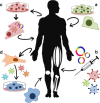Gene and cell therapy for muscle regeneration
- PMID: 25899573
- PMCID: PMC4596170
- DOI: 10.1007/s12178-015-9268-9
Gene and cell therapy for muscle regeneration
Abstract
Skeletal muscle injury and healing are multifactorial processes, involving three steps of healing: (1) degeneration and inflammation, (2) regeneration, and (3) fibrosis. Fibrous tissue hinders the muscle's complete recovery and current therapies fail in achieving total muscle recovery. Gene and cell therapy (or both) are potential future treatments for severe muscular injuries. Stem cells' properties associated with growth factors or/and cytokines can improve muscle healing and permit long-term recovery.
Figures
Similar articles
-
Stem cells, angiogenesis and muscle healing: a potential role in massage therapies?Br J Sports Med. 2013 Jun;47(9):556-60. doi: 10.1136/bjsports-2012-091685. Epub 2012 Nov 29. Br J Sports Med. 2013. PMID: 23197410 Review.
-
The effects of growth factors on skeletal muscle lesions.Joints. 2014 Mar 21;1(4):180-6. eCollection 2013 Oct-Dec. Joints. 2014. PMID: 25606531 Free PMC article.
-
EFFECT OF PLATELET RICH PLASMA CONCENTRATION ON SKELETAL MUSCLE REGENERATION: AN EXPERIMENTAL STUDY.J Biol Regul Homeost Agents. 2015 Oct-Dec;29(4 Suppl):47-55. J Biol Regul Homeost Agents. 2015. PMID: 26652490
-
Stem cells, angiogenesis and muscle healing: a potential role in massage therapies?Postgrad Med J. 2013 Nov;89(1057):666-70. doi: 10.1136/postgradmedj-2012-091685rep. Postgrad Med J. 2013. PMID: 24129034
-
Therapeutic strategies for preventing skeletal muscle fibrosis after injury.Front Pharmacol. 2015 Apr 21;6:87. doi: 10.3389/fphar.2015.00087. eCollection 2015. Front Pharmacol. 2015. PMID: 25954202 Free PMC article. Review.
Cited by
-
Effect of Periodic Granulocyte Colony-Stimulating Factor Administration on Endothelial Progenitor Cells and Different Monocyte Subsets in Pediatric Patients with Muscular Dystrophies.Stem Cells Int. 2016;2016:2650849. doi: 10.1155/2016/2650849. Epub 2015 Dec 6. Stem Cells Int. 2016. PMID: 26770204 Free PMC article.
-
Exploiting Advanced Hydrogel Technologies to Address Key Challenges in Regenerative Medicine.Adv Healthc Mater. 2018 Apr;7(8):e1700939. doi: 10.1002/adhm.201700939. Epub 2018 Jan 9. Adv Healthc Mater. 2018. PMID: 29316363 Free PMC article. Review.
-
Biomaterial-Guided Gene Delivery for Musculoskeletal Tissue Repair.Tissue Eng Part B Rev. 2017 Aug;23(4):347-361. doi: 10.1089/ten.TEB.2016.0462. Epub 2017 Mar 10. Tissue Eng Part B Rev. 2017. PMID: 28166711 Free PMC article. Review.
-
Disruption of Neuromuscular Junction Following Spinal Cord Injury and Motor Neuron Diseases.Int J Mol Sci. 2024 Mar 20;25(6):3520. doi: 10.3390/ijms25063520. Int J Mol Sci. 2024. PMID: 38542497 Free PMC article. Review.
-
Ionic Silicon Protects Oxidative Damage and Promotes Skeletal Muscle Cell Regeneration.Int J Mol Sci. 2021 Jan 6;22(2):497. doi: 10.3390/ijms22020497. Int J Mol Sci. 2021. PMID: 33419056 Free PMC article.
References
-
- Huard J, Li Y, Fu FH. Muscle injuries and repair: current trends in research. J Bone Joint Surg Am. 2002;84-a(5):822–32. - PubMed
LinkOut - more resources
Full Text Sources
Other Literature Sources


